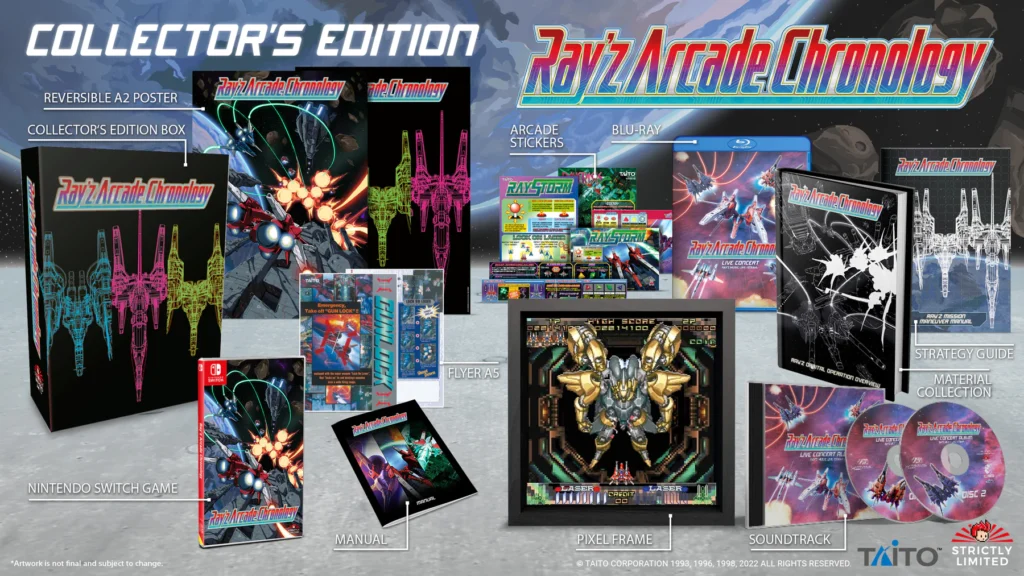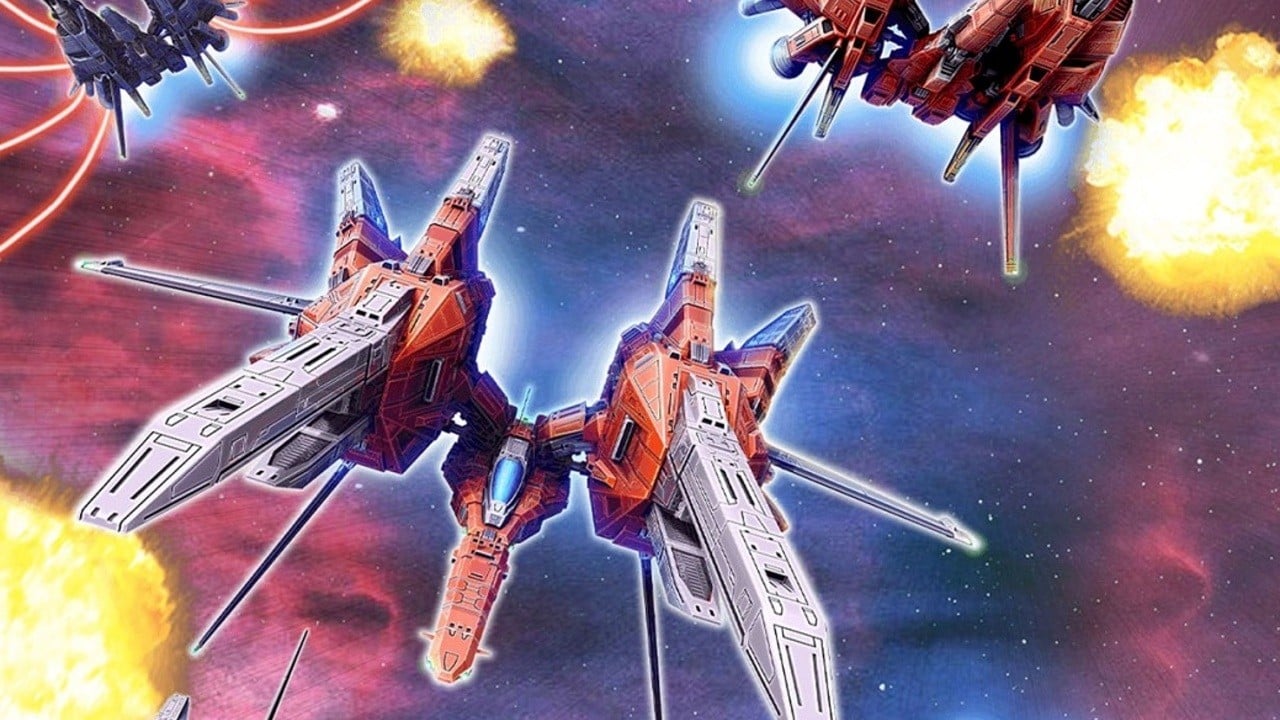This is an Ray’z Arcade Chronology review, The PlayStation 4 version was played and tested on PlayStation 5. Ray’z Arcade Chronology is available for the PlayStation 4, PlayStation 5 via backwards compatibility, and the Nintendo Switch for $49.99.
Ray’z Arcade Chronology is a compilation of five games (six if you purchase the physical copy), featuring a variety of modes and upgrades depending on the selected game. The digital version, which I will cover in this review, includes RayForce, RayStorm, and RayCrisis, along with two new and/or updated versions of RayStorm NEO-HD. Additionally, there is an updated widescreen version of the 2010 game known as RayStorm HD and a brand new release called RayCrisis HD, which is a remastered version of the 1998 classic.
Important side note: There are two different ‘Ray’ collections that were released within a short period of time, which can lead to some confusion. The key difference between the version reviewed here, Ray’z Arcade Chronology, and the other game released on June 30th known as RayStorm x RayCrisis HD Collection is that Ray’z includes the original arcade releases of the first three games in the series, along with a prototype known as R-Gear, if you purchased the physical versions from Strictly Limited Games. On the other hand, RayStorm x RayCrisis HD Collection, also released by ININ, only includes the two HD releases and does not include RayForce at all.
| Game | Version | Availability |
| Ray’z Arcade Chronology | ||
| RayCrisis | Original | Digital and physical (SLG) |
| RayStorm | Original | Digital and physical (SLG) |
| RayForce | Original | Digital and physical (SLG) |
| RayCrisis HD | HD remake | Digital and physical (SLG) |
| RayStorm NEO-HD | HD remake | Digital and physical (SLG) |
| R-Gear | Prototype | Physical only at SLG |
| RayStorm X RayCrisis HD Collection | ||
| RayCrisis HD | HD remake | Digital and physical (retail) |
| RayStorm NEO-HD | HD remake | Digital and physical (retail) |
Developed by Taito, Published by ININ
Every game in this compilation was originally developed by Taito, an almost eighty-year-old company that initially started as a seller of floor coverings, hair wigs, and hog bristles. Eventually, it became the first vodka maker in Japan and began producing electro-mechanical games in 1967. Notably, it had the highest-grossing game debut at the Tampa Fair in 1968. Fifty years ago, Taito released its first video game, Elepong, which was essentially a Pong clone, including the graphics and cabinet design. Over time, they created their own games and developed numerous intellectual properties, including the immensely popular Space Invaders, which was released forty-five years ago.
In the 1990s, Taito developed a trilogy of shmups, which I will cover here. Thanks to the publishing assistance of retro-specialist ININ Games and their physical publishing subsidiary, Strictly Limited Games, these games are now being released in the US and Europe. As is the case with many of Taito’s intellectual properties (as well as Sega’s), M2 was responsible for porting the games and bundling them together in a cohesive and well-presented collection.
RayForce
In the digital version of Ray’z Arcade Chronology, we have three great arcade originals, and two remasters of the latter two games in the series. For the record, there are no PlayStation 1 or Saturn remasters, but we have the original arcade ports here. The first being RayForce, which came out in 1994 with little hype as it sadly came out at a time where Street Fighter, Mortal Kombat, Virtual Racing, and NBA JAM were the heavy hitters at the time. It is quite a good vertically scrolling shooter with eight challenging stages.
You are provided with a ship known as the RVA-818 X-LAY, which fires fixed and moving lasers that takes out enemies, and helps to take out the obliterated remnants of Earth when the remaining 0.2% of the human population successfully gets out of orbit and onto a new colony planet. As with most shmups, the stages get progressively tougher but with a nice and fair degree of increasing difficulty. This was the only game in the trilogy with a fixed route, but plays very well and compared to the 1994 arcade port, is exceptionally faithful to the source material.

RayStorm
The second game in the series, and my personal favorite, is RayStorm, a polygonal graphical masterpiece released in 1996. In RayStorm, you take control of the R-Gray ship, which comes in two variants. The first variant is equipped with vulcan lasers and an up-to-eight-way lockdown system. The second variant retains the same abilities but offers up to sixteen locking positions, allowing you to eliminate entire fleets of enemy fighters simultaneously and deal significant damage to large bosses encountered later in the game.
In RayStorm, the Secillia Federation aims to destroy the newly created Earth in the 2100s, and it is up to you to prevent another invasion. One notable addition to RayStorm is the Special Attack. When the SP meter is full and activated, it unleashes a screen-wide assault that decimates most enemies on the screen. However, filling up this meter takes considerable time, so players must use the Special Attack wisely and sparingly, as they only have one per life. The game’s graphics are visually stunning, and its faster gameplay, compared to RayForce, combined with its compelling objectives, makes RayStorm truly flourish in the arcade and during its time of release.

RayCrisis
The third game in the series, RayCrisis, released in 1998, is notable for being the most open and challenging entry while maintaining its visually stunning graphics. Serving as a prequel to RayForce, RayCrisis presents an overhead viewpoint shooter experience where you control a Waverider, which is actually a virus. Your objective is to confront your trilogy-based enemy, the Con-Human, which is determined to eliminate the virus and you.
In RayCrisis, you must navigate through a series of stages, which can vary between seven and nine stages depending on the chosen route. Your tasks include taking out antibodies, collecting items, and maintaining stealth to avoid detection by the Con-Humans. A unique addition in this game is the encroachment system, where a percentage rating increases when you are spotted by the enemy. If the encroachment rating surpasses 100%, you will start losing points, and finishing the game with a rating over 100% results in a bad ending. It’s important to note that RayCrisis follows a one-life, one-continue format, making it quite challenging.

Options and features
One essential feature, especially in RayStorm and RayCrisis, is the option to engage Free Play. This is particularly crucial in RayCrisis, considering its “1 life, 1 continue” system. Playing these games in the arcades a quarter-century ago could drain your quarters in a matter of seconds if you were not careful. So this will open up the game significantly of course.
The difficulty can be changed in all three games but even at its easier settings these are very difficult games that demand memorization to finish. You have your typical monitor mockup settings like CRT, Scanlines, and such we all drew accustomed to from M2.
Remasters for the future
In this compilation, we are also treated to two additional remasters: RayStorm NEO-HD and RayCrisis HD. These remasters offer widescreen modes, enhanced graphics, and improved sound quality. While there isn’t much else to report in addition to the arcade ports, there is one standout feature that demonstrates thoughtfulness on the part of M2.
In RayStorm NEO-HD and RayCrisis HD, the saves and achievements you make in the arcade ports carry over seamlessly to the HD Remasters. This means that if you switch between the arcade ports and the HD versions, your progress and achievements will be retained. This thoughtful addition allows players to switch between different graphical styles without any concerns about losing their progress.
R-Gear’s physical exclusivity
One major point of contention with the digital release of Ray’z Arcade Chronology is the exclusion of R-Gear. This decision by ININ Games and Strictly Limited Games has perplexed many fans. R-Gear a cancelled game that should’ve been RayForce 1.5, serving as the supposed sequel to RayStorm. Instead of being included as a one-level demo or prototype within the digital release, R-Gear became an exclusive physical release.
This exclusive treatment of R-Gear has not been well-received by fans, to put it lightly. Particularly for those fans who prefer digital purchases or missed out on the rapidly sold-out regular physical version. The only way to get R-Gear now is the Collector’s Editions that are retailing at $/€ 130, which hasn’t sold out at the time of writing. Those who will be playing this digital only on the PlayStation 5 or Nintendo Switch have no way to play this demo otherwise.

Research
Overall, the exclusion of R-Gear from the digital release has caused frustration and disappointment among fans who feel like this treatment of limping digital releases against low numbered and highly expensive Limited Editions is reaching it’s high point Borderlining anti-consumer tactics. So, it is important for ININ Games and Strictly Limited Games to address this matter in order to ensure a more customer-friendly approach. Additionally, it would be nice to not have to do research in order to get what you expect to be getting.
Two collections deliberation
If we subtract the business side from the game content, this compilation did not disappoint at all. With three arcade games and two remasters, you do get quite a bang for your buck. There is a HD-Remastered release both physically and digitally of the RayStorm x RayCrisis HD Collection, but why jip yourself out of the three original games to save 10 dollars. Each of the three arcade releases are quite faithful to their original counterparts. There is no slowdown or lag in any of these games that for the most part plays very well with spot on controls. With the Free Play option and, in the case of RayCrisis, multiple endings, this is well worth its (digital) asking price for fans of the series and retro enthusiasts.
This compilation could have gotten an even higher score by including a remaster of RayForce, adding R-Gear to the digital version, and incorporating additional features such as boss attack mode or speedruns. It would be 'great' for ININ Games (and Strictly) to consider digital-only gamers and avoid making significant content exclusive to physical copies. The R-Gear fiasco has crippled this compilation somewhat, despite the excellent source material and M2's nurturing treatment.


